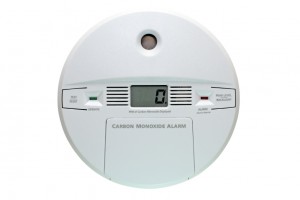 The first thing we need to understated is, Carbon Monoxide or CO detectors are not the same as a smoke detector even though they often look very much alike. Smoke detectors alert occupants to the presence of smoke and or fire where CO detectors let them know when the deadly gas, Carbon Monoxide, is present. CO is a colorless, odorless gas that all too often proves to be deadly. Often people believe they can smell CO, which is false. It is accurate that natural gas and propane produced for home use can be detected by smell, but that is because another gas is added to them as an odorant. Without this other gas, you would not smell a leak. Natural gas and propane are only two examples of where a home may encounter CO gas. Faulty heating equipment, generators, and fireplaces can leak CO into a home without the occupants smelling it as well.
The first thing we need to understated is, Carbon Monoxide or CO detectors are not the same as a smoke detector even though they often look very much alike. Smoke detectors alert occupants to the presence of smoke and or fire where CO detectors let them know when the deadly gas, Carbon Monoxide, is present. CO is a colorless, odorless gas that all too often proves to be deadly. Often people believe they can smell CO, which is false. It is accurate that natural gas and propane produced for home use can be detected by smell, but that is because another gas is added to them as an odorant. Without this other gas, you would not smell a leak. Natural gas and propane are only two examples of where a home may encounter CO gas. Faulty heating equipment, generators, and fireplaces can leak CO into a home without the occupants smelling it as well.
Since CO cannot be detected by humans, a detector is needed to know if it is present. At a minimum, every home should have at least one CO detector installed near the sleeping area of the home. Other areas should have them installed as well such as basements, attics, and living areas of the home. When you install your CO detectors, make sure you follow the manufacturers instructions since there are variations on where to install them depending on the brand. The best installation will include a monitoring service which will alert the home owner and emergency services in the event of an alarm activation.
In small doses, the CDC says CO can actually make the occupants feel as if they have flu like symptoms such as headache, weakness, nausea, vomiting, chest pain, and confusion. With too long of an exposure or at high concentrations for a short period of time, CO can actually prove to be deadly. According to the CDC, more than 400 americans die each year from exposure to CO gas. The majority of these deaths occur from utilizing generators indoors and faulty heating and cooking appliances. Had these homes had a properly functioning CO detector, these deaths would not have occurred. If your CO detector begins to alarm, exit your home and dial 911 to have first responders check your home until the gas company can arrive.
